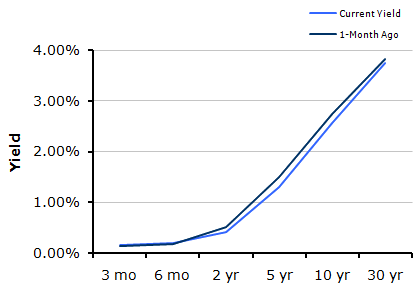
Market Commentary by Scott J. Brown, Ph.D., Chief Economist

Same old story. The economic data reports remained consistent with a near-term slowdown in the pace of growth, but not a double dip. The estimate of second-quarter 2010 real gross domestic product (GDP) growth was revised to 1.7% (compared to 1.6% in the second estimate and 2.4% in the advance estimate). Personal income rose 0.5% in August – more than expected – but was boosted partly by the extension of unemployment insurance benefits. Consumer spending rose 0.4% (up 0.2%, adjusting for inflation – about a 2% annual rate in the third quarter of 2010). The Institute for Supply Management (ISM) Manufacturing Index slowed about as anticipated in September.
We have two new Federal Reserve governors: Janet Yellen (appointed vice chair of the Fed) and Sarah Bloom Raskin. The Wall Street Journal reported that Fed officials are considering smaller-scale quantitative easing. During the financial crisis, the Fed announced large-scale plans to purchase mortgage-backed securities and Treasuries over a period of months. Instead, the Fed may now announce smaller purchases over a month or so. This would give the Fed greater flexibility in monetary policy accommodation, and it presumably would be easier to get some of the more moderate Fed officials to go along. However, the Fed has not made any decisions on whether to increase its purchases of long-term securities.
Next week, the focus will be on Friday’s job market data. We lost another 78,000 temporary census workers between mid-August and mid-September (leaving a little over 6,000), which is likely to be enough to push the headline payroll change into negative territory again. Private-sector payrolls are expected to rise roughly in line with the recent trend (about 65,000) and we may see another dip in state and local government payrolls – reflecting budget pressures. The unemployment rate is expected to be flat – at 9.6% – or slightly higher.
Indices
| Last | Last Week | YTD return % | |
| DJIA | 10788.05 | 10662.42 | 3.45% |
| NASDAQ | 2368.62 | 2327.08 | 4.38% |
| S&P 500 | 1141.2 | 1124.83 | 2.34% |
| MSCI EAFE | 1561.01 | 1545.07 | -1.25% |
| Russell 2000 | 676.14 | 648.84 | 8.11% |
Consumer Money Rates
| Last | 1-year ago | |
| Prime Rate | 3.25 | 3.25 |
| Fed Funds | 0.25 | 0.25 |
| 30-year mortgage | 4.47 | 5.16 |
Currencies
| Last | 1-year ago | |
| Dollars per British Pound | 1.573 | 1.602 |
| Dollars per Euro | 1.362 | 1.464 |
| Japanese Yen per Dollar | 83.460 | 89.680 |
| Canadian Dollars per Dollar | 1.029 | 1.069 |
| Mexican Peso per Dollar | 12.601 | 13.488 |
Commodities
| Last | 1-year ago | |
| Crude Oil | 79.97 | 70.61 |
| Gold | 1307.53 | 1007.65 |
Bond Rates
| Last | 1-month ago | |
| 2-year treasury | 0.42 | 0.52 |
| 10-year treasury | 2.56 | 2.74 |
| 10-year municipal (TEY) | 3.86 | 3.59 |
Treasury Yield Curve – 10/01/2010

S&P Sector Performance (YTD) – 10/01/2010

Economic Calendar
| October 4th | — | Factory Orders (August) Pending Home Sales Index (August) |
| October 5th | — | ISM Non-Manufacturing Index (September) |
| October 6th | — | Corporate Layoff Intentions (September) |
| October 7th | — | Jobless Claims (week ending October 1st) |
| October 8th | — | Employment Report (September) |
| October 11th | — | Columbus Day (bond market closed) |
| October 15th | — | Consumer Price Index (September) Retail Sales (September) |
| November 2th/3rd | — | FOMC Meeting |
Important Disclosures
Past performance is not a guarantee of future results. There are special risks involved with global investing related to market and currency fluctuations, economic and political instability, and different financial accounting standards. The above material has been obtained from sources considered reliable, but we do not guarantee that it is accurate or complete. There is no assurance that any trends mentioned will continue in the future. While interest on municipal bonds is generally exempt from federal income tax, it may be subject to the federal alternative minimum tax, state or local taxes. In addition, certain municipal bonds (such as Build America Bonds) are issued without a federal tax exemption, which subjects the related interest income to federal income tax. Investing involves risk and investors may incur a profit or a loss.
US government bonds and treasury bills are guaranteed by the US government and, if held to maturity, offer a fixed rate of return and guaranteed principal value. US government bonds are issued and guaranteed as to the timely payment of principal and interest by the federal government. Treasury bills are certificates reflecting short-term (less than one year) obligations of the US government.
Commodities trading is generally considered speculative because of the significant potential for investment loss. Markets for commodities are likely to be volatile and there may be sharp price fluctuations even during periods when prices overall are rising. Specific sector investing can be subject to different and greater risks than more diversified investments.
Tax Equiv Muni yields (TEY) assume a 35% tax rate on triple-A rated, tax-exempt insured revenue bonds.
![]() Material prepared by Raymond James for use by its financial advisors.
Material prepared by Raymond James for use by its financial advisors.
The information contained herein has been obtained from sources considered reliable, but we do not guarantee that the foregoing material is accurate or complete. Data source: Bloomberg, as of close of business September 30th, 2010.
©2010 Raymond James Financial Services, Inc. member FINRA / SIPC.


